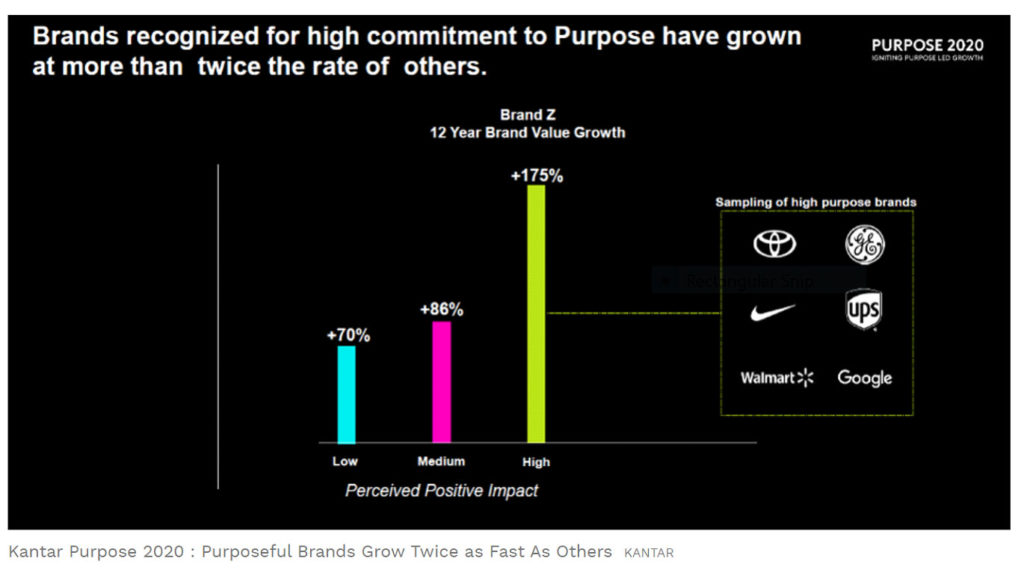Consumers want their brands to stand for something more than the products and services that they sell. A company with a high commitment to purpose and a perceived positive impact will compete better in the marketplace and gain the respect of both loyal and new customers. Kantar’s newest study shows just how powerful purpose is to a company’s growth.
With purposeful brands growing twice as fast as others, purpose should be at the forefront of your strategy and if not already, at the heart of what you do. Why does your company exist? What is the “why” behind what you do? What does your business stand for?
When Nike decided to use Colin Kaepernick for their ad campaign, it reflected a brave move by a brand to stand up for something, even if it meant taking a controversial stance that would more than likely make waves. And it did just that. At the same time that positive feedback was being received, there were also many conversations on social media of a company boycott and accusations that the brand was disrespecting the United States.
In September of 2014, CVS became the first national retail pharmacy chain to stop selling tobacco products in all of their stores because it conflicted with their purpose of helping their customers improve their health. When CVS stopped selling cigarettes, they saw brand preference increase by 50%, as a result.
Are these moves careful tactics to increase brand awareness or do they represent meaningful movements that will stand the test of time? Kantar has identified 3 steps to ensure that your company moves its purpose from a tactic to a movement that will support your brand and align with the priorities of your consumers.
Articulation
We all know what we do and how we do it, but what about why we do it? The why can be a harder concept to nail down and clearly articulate to your customers (and employees!).
Dove is an exemplary company that has identified their purpose and clarified their position. They have made it clear that they do more than sell soap and hygiene products; they are driven to improve the self-esteem of girls worldwide. Dove’s #speakbeautiful movement has made their company relatable with a sense of purpose, and they wouldn’t be able to accomplish that without clarity of intent.
Your position must be clear to your audience. Consistent and easy-to-consume messages will travel a lot further than diluted, vague, and confusing content. A true movement starts with the foundation of a coherent message that will resonate with and make sense to your audience. Start there and don’t stop until it’s perfect. A unique and actionable purpose that your consumers can easily understand and connect with is the first step to making your purpose a long-term movement, rather than a short-term goal.
Infusion
At the popular South by Southwest conference in Austin, Texas, marketers from PepsiCo and Stella Artois discussed how going past purely product-based messaging is helping their companies. PepsiCo’s VP of Marketing, specifically mentioned that, although your purpose doesn’t have to be related to an uber-trendy political or social cause, quarterly philanthropic activities and yearly donations just aren’t cutting it anymore. Followers need to see the infusion of your purpose heavily integrated into your day-to-day marketing efforts.
Investing too heavily in articulating your mission, without considering the actionable elements, will not bring in the results that you are hoping for. You must connect your employees with your purpose and that begins from the top down. The infusion of your message into your brand is a leadership-driven process that will fail without the support of the c-suite, managers, and other company leaders. Your purpose belongs in your company culture and should be an integral part of all strategies moving forward. When you take a 360-look at your brand, you should see your purpose at all angles and implemented at all levels. This will take your vision from marketing gimmick to purpose-driven movement.
Amplification
In 1997, Steve Jobs said, “Marketing is about values.” He continued to explain that Apple was launching a new ad campaign that would answer questions such as, Who is Apple? and What does Apple stand for? “Apple at the core, its core brand values… we believe that people with passion can change the world for the better,” Jobs explained. He continued by sharing the new campaign theme, “Think different,” and the rest is history. Now, we’re not surprised that Steve Jobs was ahead of the curve, but it serves as a reminder that, as a company, the long-term effects are exactly what we’re aiming for, rather than a short-term campaign that has a start and stop.
The way that purpose fits into your brand should not be an isolated tactic to improve sales or a one-time commercial to show off your brand. Think of purpose as a deep-rooted brand promise to society, a company-wide belief system, or a business-led movement.
In order to amplify your purpose so that it withstands the test of time and remains woven into the fabric of your company, it must fuel conversation. Your company must act as a role model for the cause that you are supporting through your brand’s messaging, social media, and consumer interactions. Collaborating on how to continue to drive your purpose is key to ensuring that your approach remains fresh, applicable, and relevant to you, your employees, and your customers. If the conversation starts to dry up or your collaborative efforts seem stale, go back to the why, and take a new approach to your brand’s stance.
Is the purpose of a company to make a profit or create jobs? What about create shareholder value? Purpose-driven marketing is taking center stage and it’s blowing past the traditional, economical-driven way of thinking of why a company exists. Based on Kantar’s compelling study about the way that purpose impacts your company, it’s clear that there has never been a better time to get your team together and update your purpose, inevitably creating a powerful growth strategy for your company.
It’s about making a difference, providing a sense of meaning, and utilizing your company’s purpose to make an impact that goes beyond the footprint of your business. It’s about something that goes beyond your company doors. Plan for purpose and you’ll plan for growth.


